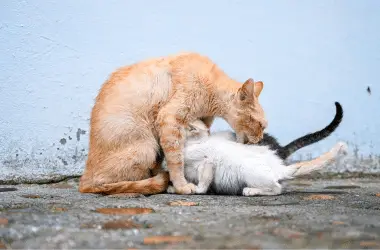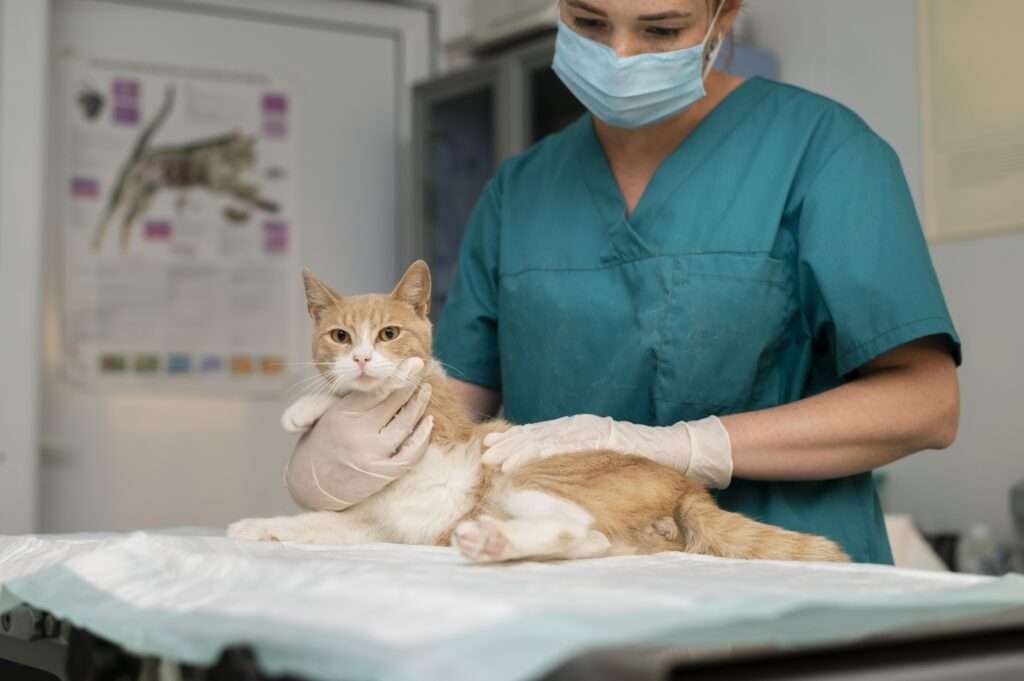Introduction:
Ever wondered why your cat insists on showing you her kittens? This behavior holds more meaning than meets the eye. In this article on “Why does my cat keep bringing me her kittens?” we unravel the reasons behind this endearing habit and share practical insights for a deeper connection with your feline friend.
Let’s explore the fascinating world of cat communication together—short, sweet, and packed with valuable tips for every cat owner.

Table of Contents
II. Understanding the Cat’s Instinct
A. Maternal Instinct in Cats:
Cats, by nature, are highly maternal creatures. This inherent instinct often manifests in behaviors such as grooming, nursing, and protecting their offspring.
Understanding this maternal drive is key to deciphering why a cat might feel compelled to bring her kittens to you. Exploring the depths of this instinct sheds light on the deep emotional connection cats form with their young.
B. Protective Behavior:
The act of bringing kittens to their human caregivers is not merely a display but a protective measure. In the wild, a mother cat relocates her kittens to ensure their safety from potential threats. By extending this behavior to human environments, domestic cats may be seeking a secure space for their young, expressing trust in their human companions.
Understanding the protective aspect provides valuable insights into the dynamics of the feline-human bond.
C. Natural Hunting and Nurturing Instincts:
Cats are natural hunters, and their nurturing instincts are closely tied to their hunting prowess. Bringing kittens to their human caregivers could be a way for cats to involve them in the nurturing process.
This behavior mirrors the wild, where mother cats introduce their young to hunting techniques. Unraveling the connection between hunting and nurturing instincts provides a holistic perspective on why this behavior persists in domestic settings.
In this section, we’ve delved into the maternal, protective, and nurturing instincts that contribute to a cat’s behavior of bringing her kittens to her human caregiver. Understanding these fundamental aspects lays the groundwork for interpreting the significance behind this endearing feline habit.
III. Reasons Behind the Behaviour
A. Trust and Bonding:
One of the primary reasons a cat bringing her kittens to her human caregiver lies in the foundation of trust and bonding. Cats are known for forming strong bonds with their owners, and this behavior is an extension of that connection.
By sharing her precious offspring, a cat expresses a deep level of trust, signaling a close bond between feline and human.
B. Seeking Approval or Assistance:
In the feline world, bringing kittens to a caregiver could be a subtle plea for approval or assistance. Cats are perceptive animals, and they often gauge human reactions. By presenting her young, a cat might be seeking reassurance or help in caring for the kittens.
Understanding the cat’s need for approval sheds light on the nuanced ways in which they communicate with their human companions.
C. Mimicking Natural Environment:
Cats are creatures of habit, and their behaviors often reflect their instincts in a domestic setting. In the wild, mother cats relocate their kittens to different safe spots.
By bringing kittens to specific locations, domestic cats might be mirroring this instinctual behavior, adapting it to their human-influenced environment. Recognizing the mimicry of natural instincts is essential to comprehending the motives behind this behavior.
In this section, we’ve explored the emotional aspects of a cat’s behavior, focusing on trust, seeking assistance, and mimicking natural instincts. These insights help demystify the reasons behind why a cat may choose to share her kittens with her human caregiver.
Understanding these motivations strengthens the human-feline bond and enriches the overall experience of cat ownership.
IV. Impact of Human Interaction
A. Influence of Human Relationships:
The dynamics between a cat and her human caregiver have a big impact on the way the cat behaves when she brings her kittens to them.
Cats are highly attuned to their owners’ emotions and behaviors. When a cat perceives a positive and secure relationship with her human, she may be more inclined to share the joy of motherhood by presenting her kittens.
Understanding the impact of human Relationships sheds light on the reciprocal nature of the bond between cats and their owners.
B. Behavioral Responses to Human Presence:
Cats are known for their sensitivity to environmental stimuli, and human presence is a crucial factor in their behavior. Bringing kittens to a human may be a cat’s way of incorporating her caregiver into the familial unit.
This behavior can be a response to the social structure that cats form within a household. Recognizing the role of human presence in influencing cat behavior contributes to a more comprehensive understanding of the shared living environment.
In this section, we’ve explored how the influence of human relationships and the behavioral responses to human presence play a pivotal role in a cat’s decision to bring her kittens to her caregiver.
Recognizing these factors enhances the appreciation of the intricate ways in which cats navigate their social interactions within the human home.
V. Medical Considerations

image credit: Freepik
A. Health and Well-Being of the Kittens:
One crucial aspect to consider when a cat brings her kittens to her human caregiver is the health and well-being of the kittens. In some cases, a mother cat may sense that her kittens require additional care or attention.
By involving the caregiver, she may be seeking assistance in ensuring the optimal health of her offspring. Understanding the link between this behavior and the kittens’ well-being is vital for responsible cat ownership.
B. Veterinary Perspective on Cat Behavior:
Consulting a veterinarian provides valuable insights into the medical considerations associated with a cat bringing her kittens to her caregiver. Medical factors such as the kittens’ health, the mother cat’s well-being, and any potential concerns should be evaluated.
A veterinarian can offer guidance on whether the behavior is a normal aspect of feline care or if there are underlying health issues that need attention. Incorporating a veterinary perspective enhances the overall understanding of the cat’s behavior.
In this section, we’ve delved into the medical considerations related to a cat’s behavior of bringing her kittens to her caregiver.
By focusing on the health and well-being of the kittens and seeking input from a veterinary professional, cat owners can ensure that they are providing the best possible care for their feline companions.
VI. Communication through Bringing Kittens
A. Cat’s Non-Verbal Communication:
Cats are masters of non-verbal communication, and bringing kittens to a human caregiver is a form of feline expression. Through body language, vocalizations, and actions, cats convey their emotions and needs. By presenting her kittens, a cat may be communicating trust, affection, or a desire for shared caregiving responsibilities.
Understanding the nuances of cat communication enhances the bond between cats and their human companions.
B. Interpretation of Cat Behavior:
Interpreting a cat’s behavior involves observing subtle cues and understanding the context in which actions occur. Bringing kittens to a caregiver may be a way for a cat to share her role as a parent or to seek assistance.
Cat owners can benefit from learning to interpret these behaviors, fostering a deeper connection with their feline friends.
Recognizing the communicative nature of this behavior is key to responding appropriately and strengthening the human-cat relationship.
In this section, we’ve explored the communication aspect of a cat bringing her kittens to her caregiver. By acknowledging the non-verbal signals and interpreting the behavior in context, cat owners can gain valuable insights into their cat’s emotional state and intentions. This understanding forms the basis for a more enriched and fulfilling relationship between humans and their feline companions.
VII. Tips for Cat Owners
A. Observing and Understanding Cat’s Cues:
- Pay attention to body Language: Cats communicate through body language. Observe your cat’s posture, tail movements, and ear positions when she brings her kittens. This can provide clues about her emotions and intentions.
- Recognize vocalizations: Cats may use vocalizations to express themselves. Listen for purring, meowing, or other sounds that accompany the behavior. These vocal cues can offer insights into your cat’s feelings.
B. Creating a Comfortable Environment:
- Provide Safe Spaces: Ensure your home has designated safe spaces for the cat and her kittens. This can include cozy beds, quiet corners, or enclosed areas where the family can bond without disturbances.
- Maintain a Calm Atmosphere: Cats thrive in calm environments. Minimize loud noises and disruptions, creating a peaceful setting that promotes a sense of security for both the mother cat and her kittens.
C. Responding Appropriately to Cat Behavior:
- Avoid Disturbances: Respect the cat’s need for privacy and bonding time with her kittens. Minimize unnecessary disturbances and allow the family to bond naturally.
- Provide Supportive Care: Offer assistance in caring for the kittens, such as providing a comfortable nest, appropriate nutrition, and regular veterinary check-ups. This collaborative approach strengthens the human-feline bond.
In this section, we’ve outlined practical tips for cat owners to navigate and enhance their understanding of a cat’s behavior when she brings her kittens. By observing cues, creating a comfortable environment, and responding appropriately, cat owners can foster a positive and harmonious relationship with their feline companions during this special time.
VIII. Discouraging the Behavior
A. Addressing Unwanted Behavior:
- Identify Unwanted Aspects: Determine whether the behavior of bringing kittens poses any challenges or concerns within the household. This could include disruptions, hygiene issues, or discomfort for the cat or the family.
- Implement Gentle Corrections: If necessary, gently discourage the behavior by redirecting the cat’s attention or providing alternative activities. Avoid using punitive measures, as these can negatively impact the cat-human relationship.
B. Training and Positive Reinforcement:
- Introduce Training Techniques: Implement positive reinforcement techniques to encourage desired behaviors. For instance, reward the cat for spending time with her kittens in designated areas or engaging in other positive interactions.
- Create a Routine: Establishing a routine can help modify the behavior over time. Provide consistent positive reinforcement when the cat displays desirable actions, reinforcing the idea that certain behaviors are associated with positive outcomes.
In this section, we’ve discussed strategies for cat owners to address and, if necessary, discourage the behavior of a cat bringing her kittens. By identifying unwanted aspects and implementing gentle corrections along with positive reinforcement, cat owners can guide their cats toward behaviors that align with household preferences while maintaining a positive and supportive environment.
Conclusion: Why does my cat keep bringing me her kittens?
In conclusion, when your cat brings her kittens to you, it’s like she’s saying, “I trust you, and we’re a family.” This cute behavior shows her natural mom instincts and the close bond you share. Gaining even deeper insight into your cat’s behavior—such as heeding her cues and ensuring the health of her kittens—will strengthen your bond. You can create a happy environment for yourself and your furry family at home by applying constructive techniques and learning from real life experiences.
Thus, the next time your cat gives birth to kittens, savor the occasion as it is her way of letting you know how much she values you.


